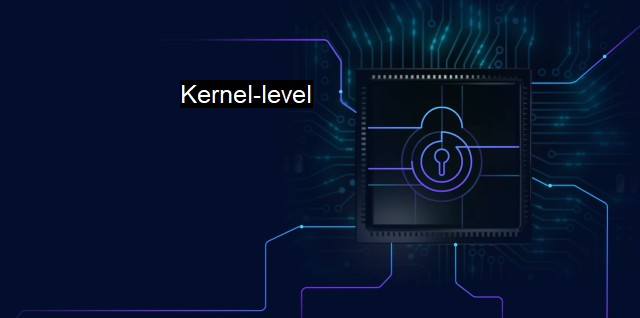What is Kernel-level?
Kernel-Level Security Features: Protecting Your Computer from Cybersecurity Threats through Holistic System Resources and Privileged Modes
Kernel-level is a concept in computer science linked strongly with cybersecurity, antiviruses, and other measures of data protection. To completely assimilate the concept of "kernel-level" within the frame of cybersecurity, it is necessary first to grasp what "kernel" is in computer theory.The kernel is a fundamental part of an operating system (OS), be it Windows, Linux, or Mac OS. It is a program that constitutes the core of an OS, handling low-level operations and controlling everything in the system beneath user-facing applications. Kernel's primary purpose is to manage the system's resources and facilitate smooth interactions between the system's hardware and software components.
The kernel operates in what is known as the 'kernel-mode' or 'kernel-space,' also called 'privileged mode.' It is a protected area of memory where the kernel and other system-critical utilities run, preventing ordinary applications or tools from interfering with their functionality.
Consequently, when we employ the term "kernel-level" in the context of cybersecurity or antivirus operations, it refers to the activities rooted at the same hierarchical level as the kernel, taking place at the heart of the system. At this level, utilities possess comprehensive access and control over every component of the system. Understanding the kernel-level intercepts is pivotal in reinforcing a system's protections because these kinds of applications can intervene directly with the system's fundamental actions or the kernel's processes.
Treating operations at the kernel level grants extraordinary privileges and control. These operations can detect, treat, or remove system threats, which wields significant implications for both data protection and antivirus solutions.
Concerning antivirus operations, the term "kernel-level scanning" refers to the antivirus program plunging into the same operational level as the kernel. This positioning proffers the ability to carry out deep system scans, monitor all system activities in real-time, and nip security threats in the bud before they cause any substantial harm.
Yet, it also signifies risk and increased vulnerability. If an antagonistic program or piece of malware gains full access and control at the kernel level, it can manipulate the heart of the system, inflicting catastrophic damage or system crashes. It could potentially facilitate backdoor entries for other malicious software, render existing cybersecurity solutions powerless, and even seize control over data management, protection, and control systems.
Therefore, antivirus programs functioning at the kernel level must themselves possess a high-security design. They also must consider zealous protective measures to seal any potential weak links that might permit a swing around of control at the kernel level.
The kernel-level, thus, within the cybersecurity framework, provides an exceptional dual-edge advantage. It is both a most potent ally in averting cybersecurity threats and a potent antagonist if compromised. It is indispensable for proficient cybersecurity and antivirus remedies designed to detect, fend off, and eradicate threats looming at the heart of computing systems, yet without appropriate safety countermeasures, operations at the kernel level could inadvertently pave the way for perilous security breaches.
"kernel-level," is of paramount significance; an oasis of all-encompassing cybersecurity solutions and the Achilles' heel that can pose dangerous vulnerabilities. Acknowledging its importance prods at the same time to innovating resilient and highly hardcoded antivirus programs and continually fine-tuning existing kernels to retain the balance between power and unpredictability. Its role in the fight against virtual threats continues to expand and retain pivotal significance in strengthening the precepts of cybersecurity.

Kernel-level FAQs
What does kernel-level mean in cybersecurity?
In cybersecurity, kernel-level refers to the lowest level of the operating system where code and processes are executed. It is a critical component of the system and controls access to system resources.Why is kernel-level important for antivirus software?
Antivirus software operates at the kernel-level to have deep access to system resources and monitor all system activities. This allows the antivirus to detect and stop malicious code from executing before it can cause harm to the system.Can kernel-level vulnerabilities be exploited by hackers?
Yes, kernel-level vulnerabilities are highly sought after by hackers as exploiting these can provide them with full control over the system. Therefore, it is crucial to keep the system up-to-date with the latest security patches to minimize the risk of such attacks.How does kernel-level protection differ from user-level protection?
User-level protection operates at a higher level of the operating system and cannot protect against attacks at the kernel-level. Kernel-level protection, on the other hand, has direct access to system resources and can protect against a wider range of threats.| | A | | | B | | | C | | | D | | | E | | | F | | | G | | | H | | | I | | | J | | | K | | | L | | | M | |
| | N | | | O | | | P | | | Q | | | R | | | S | | | T | | | U | | | V | | | W | | | X | | | Y | | | Z | |
| | 1 | | | 2 | | | 3 | | | 4 | | | 7 | | | 8 | | |||||||